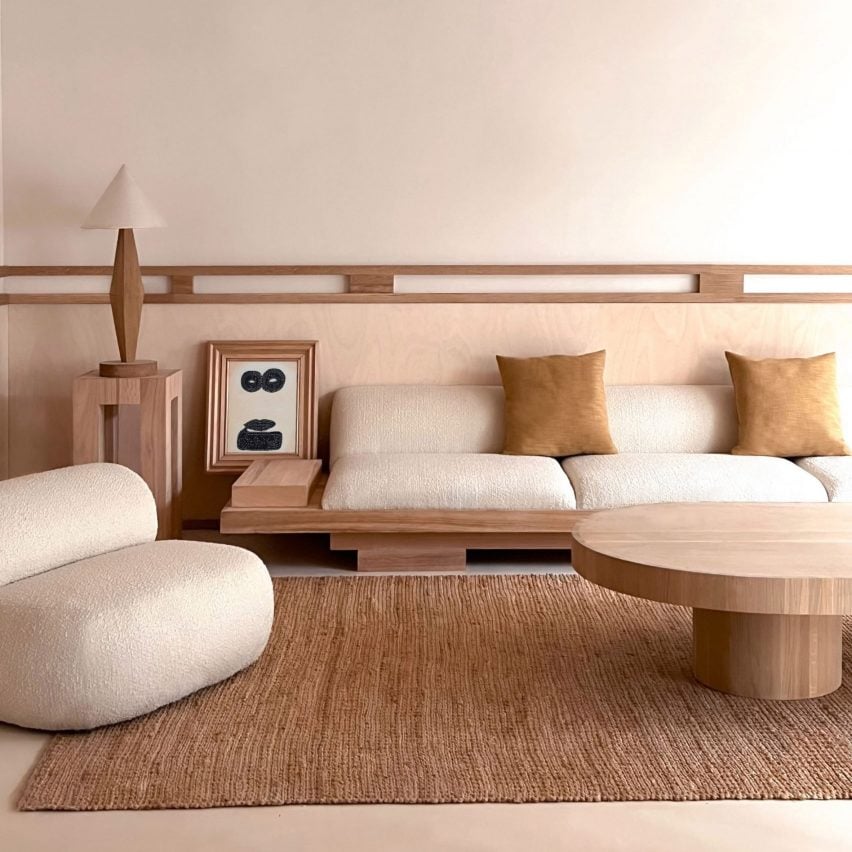Featuring a boutique retreat on the Mexican coast, a skinny building in Tokyo and an ex-sanatorium in the Greek mountains, here are 10 of the most memorable hotels published on Dezeen in 2024.

Vocabolo Moscatelli, Italy, by Archiloop
Florence studio Archiloop helped convert a 12th-century monastery on a remote estate in Italy’s Umbria region into a boutique hotel.
The 800-year-old buildings were carefully restored, with the original wooden floors, exposed brickwork and ceiling beams among the features kept. New additions include a travertine swimming pool coloured to match the surrounding woodland.
Find out more about Vocabolo Moscatelli ›

Hotel Rakuragu, Japan, by Kooo Architects
Squeezed between two buildings on a site of just 83.5 square metres, this Tokyo hotel’s constrained space inspired its distinctive design.
Japanese studio Kooo Architects created gaps in the building‘s facade by incorporating cut-out balconies that let in light while preserving privacy.
Find out more about Hotel Rakuragu ›

Casa Yuma, Mexico, by TAAC and Sara Skalli
Architecture studio TAAC and interior designer Sara Skalli utilised traditional, regionally-sourced materials to create this seaside hotel in Playa Los Naranjos.
The material palette centres around the use of chukum, a water-resistant and plaster-like finish made from tree resin and limestone, to create “an ambience that is both organic and sustainable”.
Find out more about Casa Yuma ›

Palazzo Talia, Italy, by Studiolucaguadagnino
Originally built in the 16th century, this palazzo was turned into a luxury hotel by the interior design studio of film director Luca Guadagnino, marking its first venture into hospitality.
The design combines historic features with contemporary elements, featuring 18th-century frescoes painted by Italian artist Gaspare Serenario, a floral carpet in the reception lobby and a rich colour palette to achieve a “balanced decorative effect”.
Find out more about Palazzo Talia ›

Floating Hotel, China, by More Architecture
A large zigzagging roof crowns this hotel nestled within the bamboo forests and mountains of Dachangping. Perched on a grid of steel columns and raised above an open ground floor, the hotel is aptly named Floating Hotel.
Designed by Amsterdam studio More Architecture, the rooms are arranged with varied orientations to provide guests with an “immersive relationship with nature”.
Find out more about Floating Hotel ›

Populus, USA, by Studio Gang
Claimed as the “first carbon-positive hotel” in the US, this triangular-shaped hotel employs several energy-saving design techniques, including a green roof and overhanging “lids” that shade the windows.
Located in downtown Denver, architecture practice Studio Gang intended for its design to reflect the “Aspen eyes” of Colorado’s native Aspen tree.
Find out more about Populus ›

The Brecon, Switzerland, by Nicemakers
Amsterdam-based studio Nicemakers updated the interiors of this century-old chalet to feel “like a high-end version of your own home.
With wooden panelling, integrated bookshelves and mismatched mid-century modern furniture, the design studio aimed to create a series of intimate and characterful spaces that feel both personal and inviting.
Find out more about The Brecon ›

Manna, Greece, by K-Studio and Monogon
Situated within a fir forest in the mountainous region of Arcadia, this hotel was converted from an abandoned sanatorium into a wellness retreat.
Greek architecture offices K-Studio and Monogon fitted the place with natural materials and neutral tones to amplify the sense of sanctuary offered by the remote location and enhance the feeling of connection to nature.
Find out more about Manna ›

Hotel Elysée Montmartre, France, by Policronica
Design studio Policronica transformed this 850-square-metre space using almost exclusively a single species of wood, with nearly every element of the architectural woodwork and furnishings custom-designed and crafted on-site at its Lisbon workshop.
The monochrome interior, made from locally-sourced eucalyptus wood, is a nod to the studio’s signature aesthetic.
Find out more about Hotel Elysée Montmartre ›

Rosewood São Paulo, Brazil, by Jean Nouvel and Philippe Starck
French architect Jean Nouvel designed this lattice-covered tower to serve as the main accommodation hub at Rosewood São Paulo. The 25-storey concrete structure features interiors by French designer Philippe Starck that exclusively use Brazilian-sourced materials.
The tower’s tiered design creates space for large roof gardens and balconies, while its vertical timber screens integrate indigenous flora and fauna.
Find out more about Rosewood São Paulo ›

